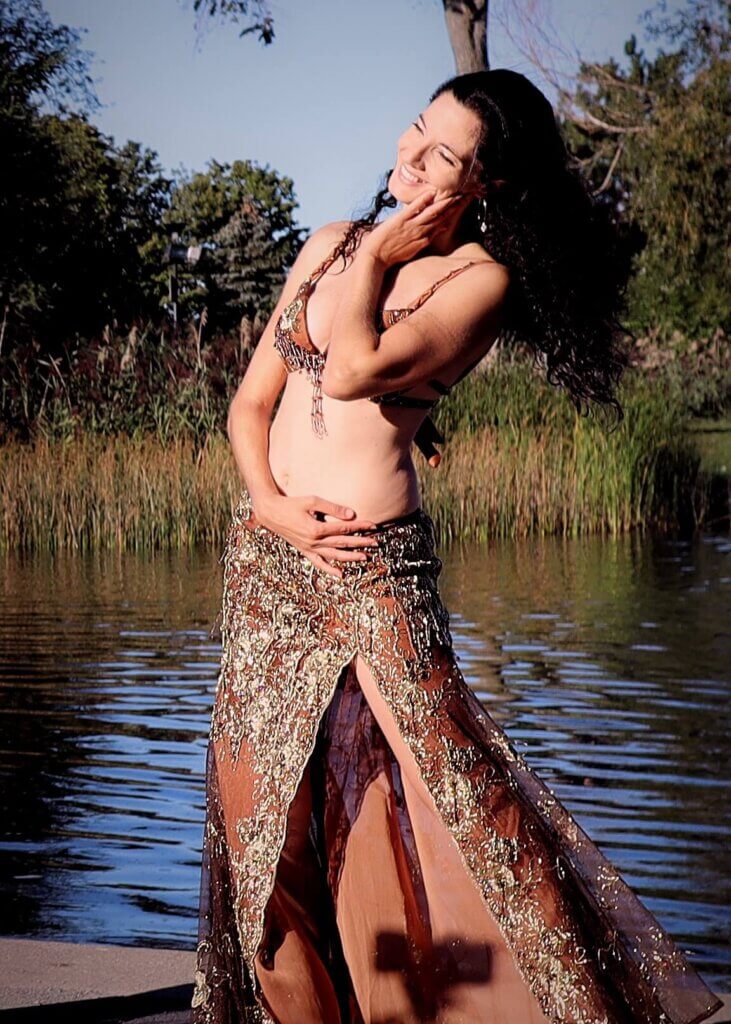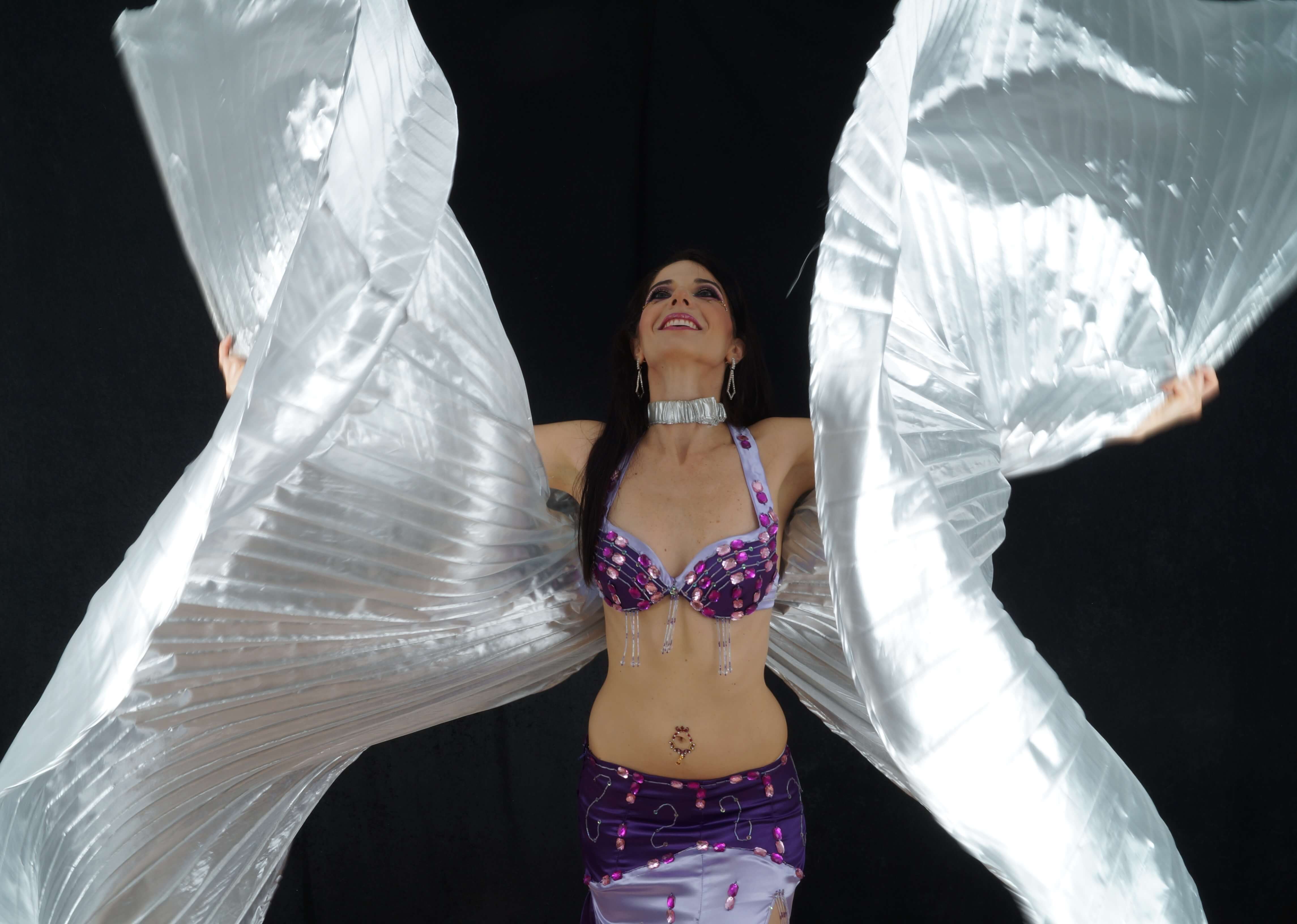Arabic dance is the artistic expression that we have cultivated the most and in a constant way for several years.
As you know, we are of Syrian descent and in our house, we were always in contact with certain traditions, such as gastronomy, certain customs and, of course, Arabic or Oriental dance.
The Beginning
It all started when we were 13 years old and attended a christening, in which an Arab dancer had been hired. The dancer seemed so beautiful and sensual that we think it was at that moment that the Arabic dance stayed in us.
But for various reasons it was not until we were 24 years old that we formally decided to learn and enrolled in an Arabic dance academy. At that time they broadcast “El Clon”, the Brazilian telenovela focused on Arab culture with many scenes of Arabic dance. Will it have influenced?
At the age of two, our training was interrupted by a study trip we made to Madrid for two years.
We resumed dancing at the age of 27, through videos… Well, I (Yuliana) started. At that stage my sister Yanelia was just watching me and correcting me, comfortably seated.
It was the time when I started to create my own choreographies and my sister Yanelia and I were invited to dance at weddings, family events, company end-of-year parties, opening of a restaurant… We were invited to dance, but Yanelia supervised.
Dance Teacher
![]()
![]()
![]()
At the age of 31 (very, very recently) we entered another academy and at the same time we began to attend workshops given by teachers and choreographers of international Arab dance who were invited to Venezuela: big names such as Jilina from the USA, Amara Sadeh from Brazil, Tito Seif from Egypt, Rania from Greece, Samira Hayek from Venezuela, among others.
A couple of years later I was presented with the opportunity to teach Arabic dance at a small academy in a commercial district of Caracas. A year later, the academy closed, I hope not because of me. Maybe because of Yanelia who sat oversaw…
So I started teaching from home. Classes that Yanelia attended… Unpaid. In Canada we have continued to dance at international culture festivals… As you can see, Arab dance, like all true love, has remained in time.
Brief description
 Oriental dance is characterized by its smooth and fluid movements, dissociating and coordinating at the same time the different parts of the body. For example, the arms may go at a different pace than the one marking the hip.
Oriental dance is characterized by its smooth and fluid movements, dissociating and coordinating at the same time the different parts of the body. For example, the arms may go at a different pace than the one marking the hip.
The focus is mainly on the hip and belly, alternating fast and slow movements and emphasizes the abdominal muscles, with chest and shoulder movements, as well as with meandering arms.
Over the years, some traditional elements have been included to “adorn” this type of dance, such as: veils, sabre, cane, candles, crotalos, wings of Isis, etc. Although this dance is usually female, there are also some male dancers.
For belly dancing, virtually all kinds of music from Middle Eastern countries is used. There are different rhythms depending on the country and region, and many dancers employ several: tawil, sherk, baladi, maksum, konga masri, rumba masri, samai, masmoudi, saidi.
Movements that express moods and symbolisms
The wave movements, rotating, which are usually slow symbolize sadness; instead with the fast movements, blows and vibrations the dancer expresses joy.
Arabic dance is very personal. There are no two dancers who dance the same, because there are no two people who feel exactly the same way.
All the movements of this dance are related to nature, for example, the soles of the feet rest well on the ground, which symbolizes the earth, or also when the dancer extends her arms they always form a semi U and are never fallen, this symbolizes the birds.
Physical Benefits
Dancing is a good cardiovascular exercise, it helps to improve both flexibility and strength. It focuses mainly on the muscles of the torso, although it also improves the strength in the legs.
Many dance styles emphasize working in isolation muscles, teaching how to move several muscles or muscle groups independently.
Routines incorporating the veil also strengthen the arms, shoulders and upper trunk in general, while the crotalos increase the strength of the fingers, working them one by one.
Oriental dance is appropriate for all ages and an intense sixty-minute session can burn around 330 calories. It also improves the posture a lot. It is a discipline that has no age limit or physical context.
Psychological Benefits
![]() The practice of oriental dance has a direct effect on raising self-esteem, improves the degree of well-being of those who enjoy practicing it regularly.
The practice of oriental dance has a direct effect on raising self-esteem, improves the degree of well-being of those who enjoy practicing it regularly.
It is not surprising: going out to dance in front of an audience with the belly uncovered and then, both men and women applaud you has to strengthen your self-esteem.
On the other hand, the sensuality of the woman is discovered and strengthened, because she is able to express all ranges of moods without saying words, only with gestures. It is the basis of true sensuality: saying without saying and showing without showing.
Arabic dance is also associated with joy. The dancer’s body is filled with hormones such as endorphins (joy), dopamine (pleasure) and oxytocin (love).
It was also part of the childbirth preparation exercises, making it one of the oldest forms of instruction to make giving birth less painful and more satisfying.
It is even said that at the time of childbirth, some women of the tribe surrounded the parturient while performing belly dancing, so that she would make the same movements as a reflex act, thus reducing the pain of contractions.
In pop culture
Arabic dance has fascinated the West since Europeans began arriving in Middle Eastern countries.
The sensuality and mystery of this dance are also taken advantage of by the entertainment industry. Numerous music videos have resorted to choreographies inspired by oriental dance.
Artists such as Britney Spears, Hilary Duff, Aaliyah, Beyoncé, Rihanna, Nelly Furtado and Jessica Simpson have included her in some of their music videos. As well as Sarah Brightman on her album Harem. While it is with the Colombian artist of Lebanese descent Shakira with whom he most often is associated
Conclusions
Well, if you were wondering why we look so good, so fit, so happy and sensual (or not?), this article has given you the clue.
Arabic dance is already part of our lives, as well as being a connection with our roots and our heritage.
It is a genuine expression of the soul and feeling of the Arab people through the centuries.
And sharing such an ancient heritage makes us feel part of that legacy to the world.


